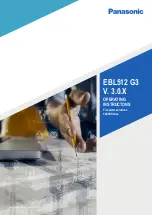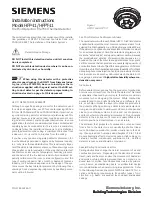
e1453b
17
Fire & Security Products
Siemens Building Technologies Group
12.2001
2.3
Wiring check
2.3.1
Test equipment
No electronic elements should be connected to the line when a system is being wired.
The line can then be tested with a universal instrument with ohmmeter or with a buzzer.
However, as this procedure cannot detect double reversed polarity, the DZB1191 base
tester has been produced.
2.3.2
Wiring check
The following procedure using the DZB1191 base tester is recommended:
DZB1191
Pos. n
Pos. 2
Pos. 1
Fig. 15
Wiring check using DZB1191 base tester
After installing the first base insert any detector.
Wire up the second base. Insert base tester. The base tester checks the line up to the
inserted detector. Remove base tester.
Wire up the third base. Insert base tester. Again the line is checked up to the inserted
detector etc.
After wiring is completed connect the end of the line at the control unit to the DZB1191.
The line is measured from the control unit to the first detector.
If present, connect the return wire and test.
If all measurements are OK, the detection line is in order.
Remove the detector from the first base.
See document x1088 «Operating instructions DZB1191» for further details.
It is also possible to install all bases and then test all bases using the same procedure.
If the detectors are inserted directly in the bases when the wiring is installed, the DZ1195
line test set is also available for the final check. For details, see document x1643, «Opera-
ting instructions DZ1195».
Please note that all bases must be tested in order to ensure that no fault is present.
Commissioning a fire detection system with faults results in time-consuming trouble-
shooting work.
2.3.3
Handing over the system
The installer is obliged to hand over to the commissioning engineer a correctly installed
and tested supply network.
Any deficiencies are normally eliminated and the work charged to the installer.



























